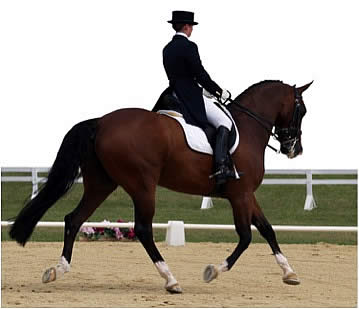Rule of Thumb
No matter what level you’re doing, you have to ride corners. The general rule for riding corners is that you don’t have to go any deeper into the corners than the smallest circle done at each level.
The smallest circle you’re asked to do at First Level is a 10-meter circle. That means you need to get into the corner to the depth of one quarter of a 10-meter circle.
At Training Level, the smallest circle you’re required to do is a 20-meter circle. So you really don’t have to get into the corners any deeper than the arc of a 20-meter circle.
But if you can show a difference between the line that you follow when you’re going into a corner and the line that you follow when you’re on a 20-meter circle, you show that you’re a savvy rider.
If it’s easy for your horse, try to show a 3-meter difference between the line you’d follow if you were going into a corner and the line you’d follow if you were on a 20-meter circle. That shows a real clear difference between getting into the corner and being on a circle.
Your rule of thumb is to ride into the corner as deep as your horse can manage — that is, he can keep the same rhythm, tempo, balance and quality of his gait.
Tips for Riding Better Corners
If your horse struggles with the bend, try one of the following exercises:
- In the walk, come off the track just before the last letter and leg yield with a bend into the heart of the corner to a point where the long and short sides meet.
As you start the leg yield, keep the bend with your inside leg on the girth, outside rein behind the girth and an indirect inside rein. Simply shift your weight to the outside seatbone to ask your horse to move sideways under your weight.
Once you can do this in the walk in all four corners, try it in the trot and later on in the canter. You’ll use your aids in the same way, but come off the track a little earlier so you have more time to leg yield into the heart of the corner.
Also, because things come up so much faster in trot and canter, only do the leg yield in the first corner of each long side.
- Just as you’re ready to enter the corner in the trot or canter, do a downward transition to the walk. And then walk very deeply into the corner.
Feel like you have the front end of your horse on the short side and the back end on the long side so his body simulates being at a right angle when you’re in the deepest part of the corner. As you leave the corner, pick up the trot again.
- Repetition of an exercise is the mildest form of correction. Keep in mind that every corner is ¼ of a circle. So if your horse doesn’t bend in a corner, turn onto a 10-meter circle in that corner. Repeat the circle until your horse feels likes he’s bending better. Then advance to the next corner.
- When ridden correctly, your horse should come out of a corner in better balance than he had going into the corner. So as you come off the track just before the last letter, give a three second set of connecting aids. Then soften the aids as you ride out of the corner.
In other words, close both legs, close your outside hand in a fist and vibrate the inside rein just before the corner and during the first stride into the corner. Then soften and go back to maintenance pressure of legs and hands to allow your horse to come out of the corner in better balance.
Jane Savoie
1174 Hill St ext.
Berlin, VT 05602
Jane’s Website
DressageMentor.com
